Principles of Commercial Law BUS503: Negligence Case Study Analysis
VerifiedAdded on 2023/01/19
|8
|2613
|85
Case Study
AI Summary
This case study analyzes a negligence claim arising from an incident at a McDonald's restaurant. The assignment explores the legal principles of negligence, including duty of care, breach of duty, causation, and defenses. It examines whether the defendant, Ravi, a manager at McDonald's, owed a duty of care to the plaintiff, Archana, a customer. The analysis delves into whether Ravi breached this duty by failing to address a slippery area and whether this breach caused Archana's injuries. The case also considers potential defenses, such as contributory negligence, given Archana's intoxication and use of high heels. Finally, the assignment assesses the extent of recoverable losses by Archana, considering issues of causation and remoteness. The analysis references relevant case law and applies legal principles to the facts presented to reach conclusions on each issue, providing a comprehensive understanding of negligence law within a commercial context.
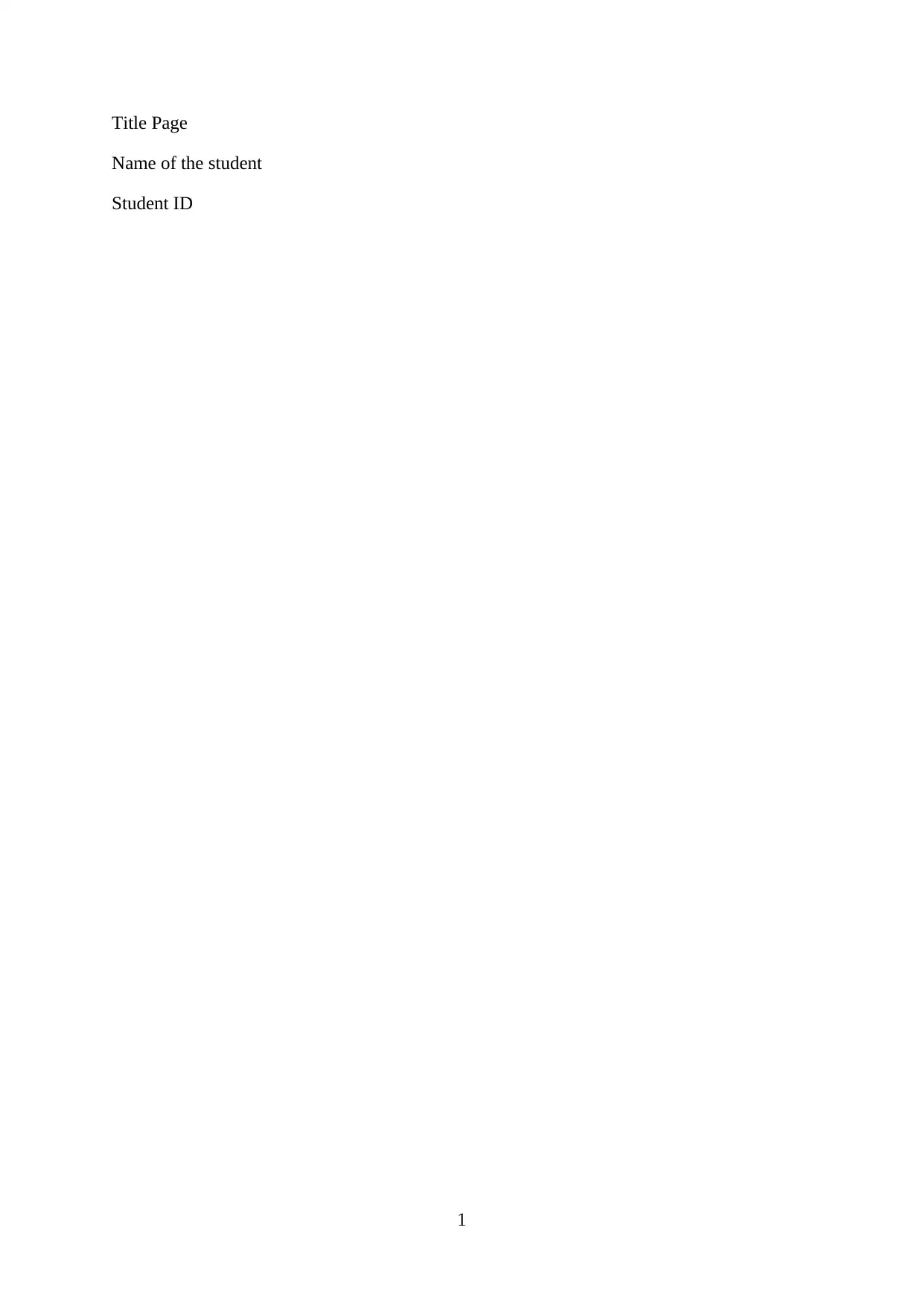
Title Page
Name of the student
Student ID
1
Name of the student
Student ID
1
Paraphrase This Document
Need a fresh take? Get an instant paraphrase of this document with our AI Paraphraser
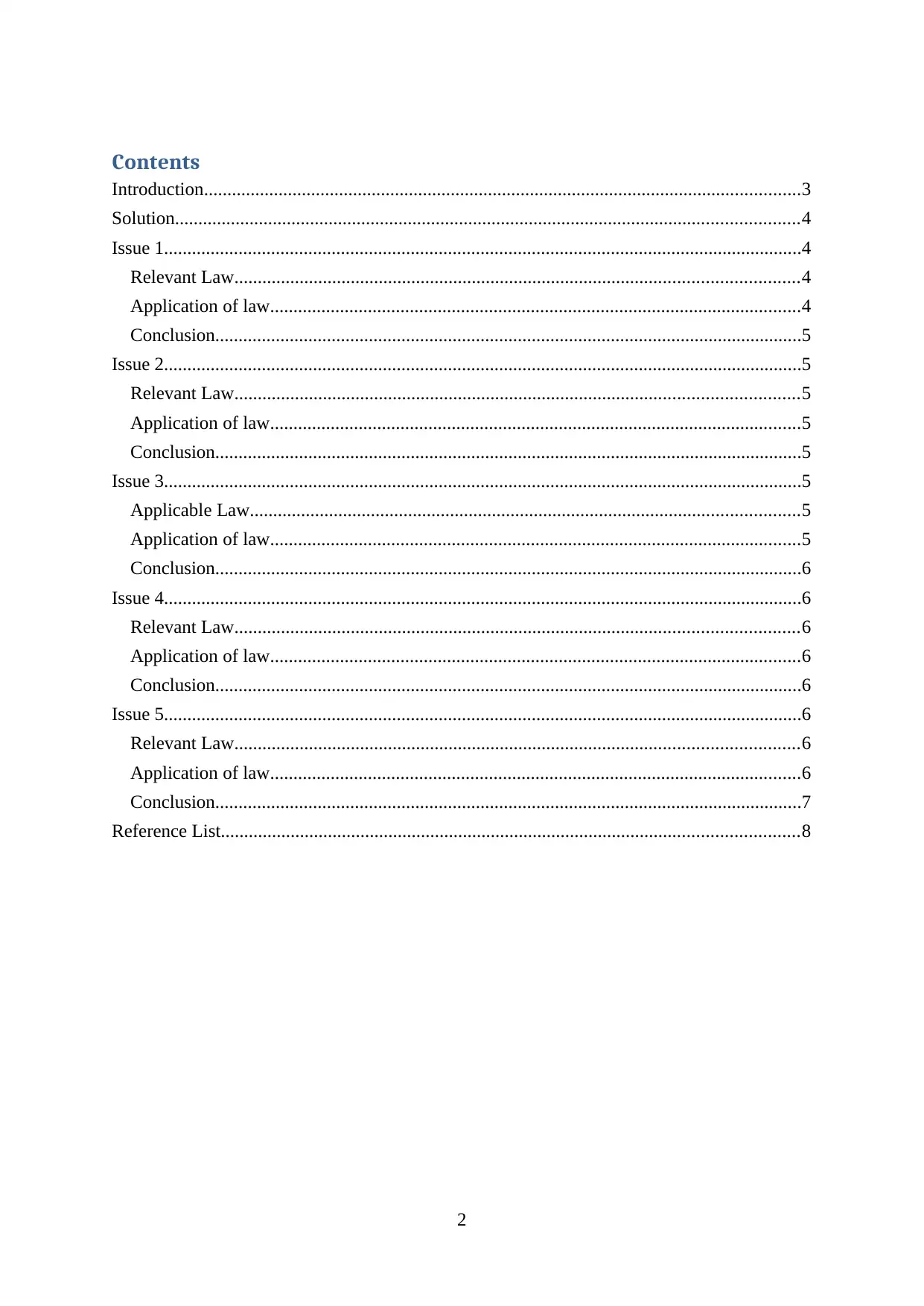
Contents
Introduction................................................................................................................................3
Solution......................................................................................................................................4
Issue 1.........................................................................................................................................4
Relevant Law.........................................................................................................................4
Application of law..................................................................................................................4
Conclusion..............................................................................................................................5
Issue 2.........................................................................................................................................5
Relevant Law.........................................................................................................................5
Application of law..................................................................................................................5
Conclusion..............................................................................................................................5
Issue 3.........................................................................................................................................5
Applicable Law......................................................................................................................5
Application of law..................................................................................................................5
Conclusion..............................................................................................................................6
Issue 4.........................................................................................................................................6
Relevant Law.........................................................................................................................6
Application of law..................................................................................................................6
Conclusion..............................................................................................................................6
Issue 5.........................................................................................................................................6
Relevant Law.........................................................................................................................6
Application of law..................................................................................................................6
Conclusion..............................................................................................................................7
Reference List............................................................................................................................8
2
Introduction................................................................................................................................3
Solution......................................................................................................................................4
Issue 1.........................................................................................................................................4
Relevant Law.........................................................................................................................4
Application of law..................................................................................................................4
Conclusion..............................................................................................................................5
Issue 2.........................................................................................................................................5
Relevant Law.........................................................................................................................5
Application of law..................................................................................................................5
Conclusion..............................................................................................................................5
Issue 3.........................................................................................................................................5
Applicable Law......................................................................................................................5
Application of law..................................................................................................................5
Conclusion..............................................................................................................................6
Issue 4.........................................................................................................................................6
Relevant Law.........................................................................................................................6
Application of law..................................................................................................................6
Conclusion..............................................................................................................................6
Issue 5.........................................................................................................................................6
Relevant Law.........................................................................................................................6
Application of law..................................................................................................................6
Conclusion..............................................................................................................................7
Reference List............................................................................................................................8
2
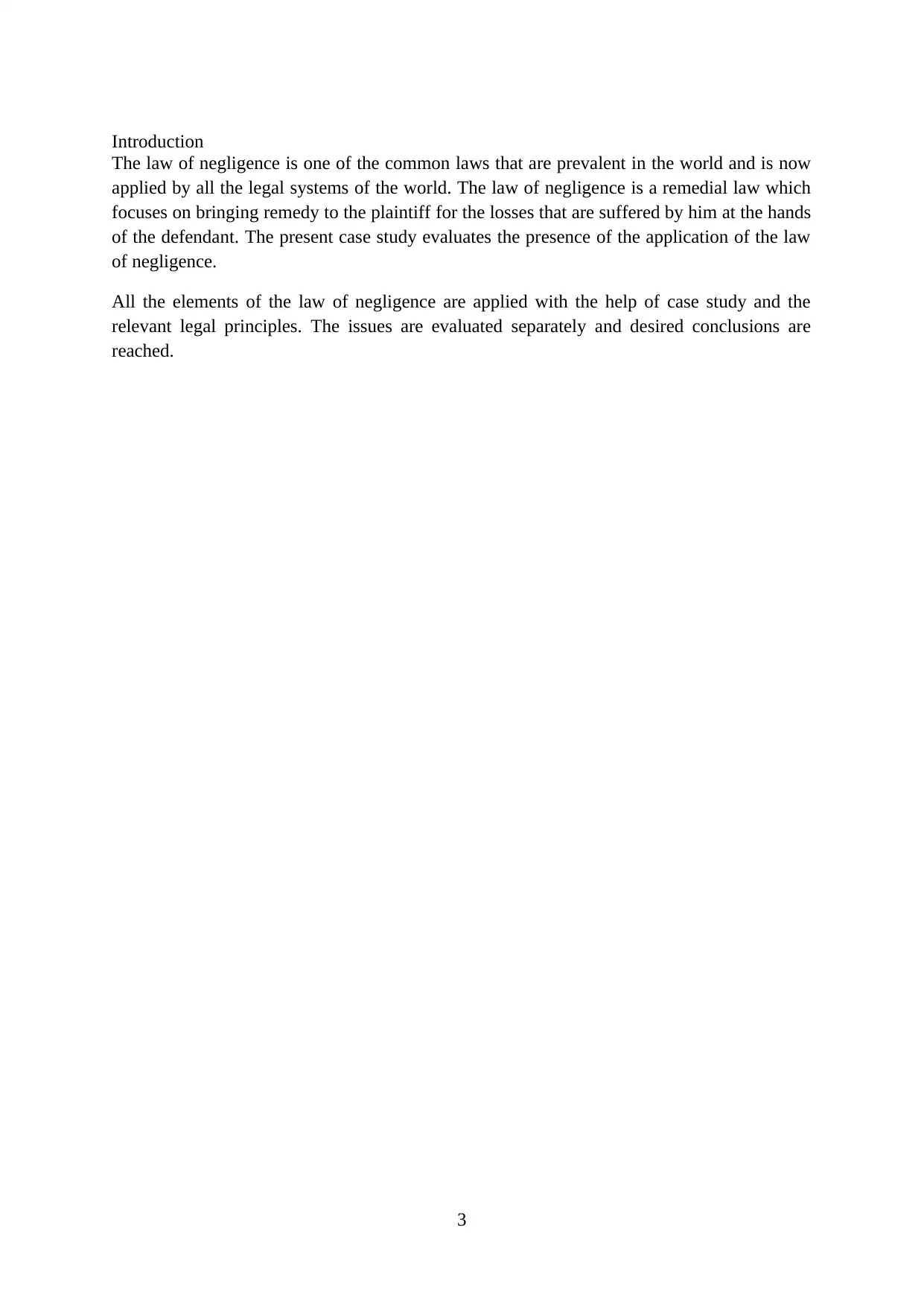
Introduction
The law of negligence is one of the common laws that are prevalent in the world and is now
applied by all the legal systems of the world. The law of negligence is a remedial law which
focuses on bringing remedy to the plaintiff for the losses that are suffered by him at the hands
of the defendant. The present case study evaluates the presence of the application of the law
of negligence.
All the elements of the law of negligence are applied with the help of case study and the
relevant legal principles. The issues are evaluated separately and desired conclusions are
reached.
3
The law of negligence is one of the common laws that are prevalent in the world and is now
applied by all the legal systems of the world. The law of negligence is a remedial law which
focuses on bringing remedy to the plaintiff for the losses that are suffered by him at the hands
of the defendant. The present case study evaluates the presence of the application of the law
of negligence.
All the elements of the law of negligence are applied with the help of case study and the
relevant legal principles. The issues are evaluated separately and desired conclusions are
reached.
3
⊘ This is a preview!⊘
Do you want full access?
Subscribe today to unlock all pages.

Trusted by 1+ million students worldwide
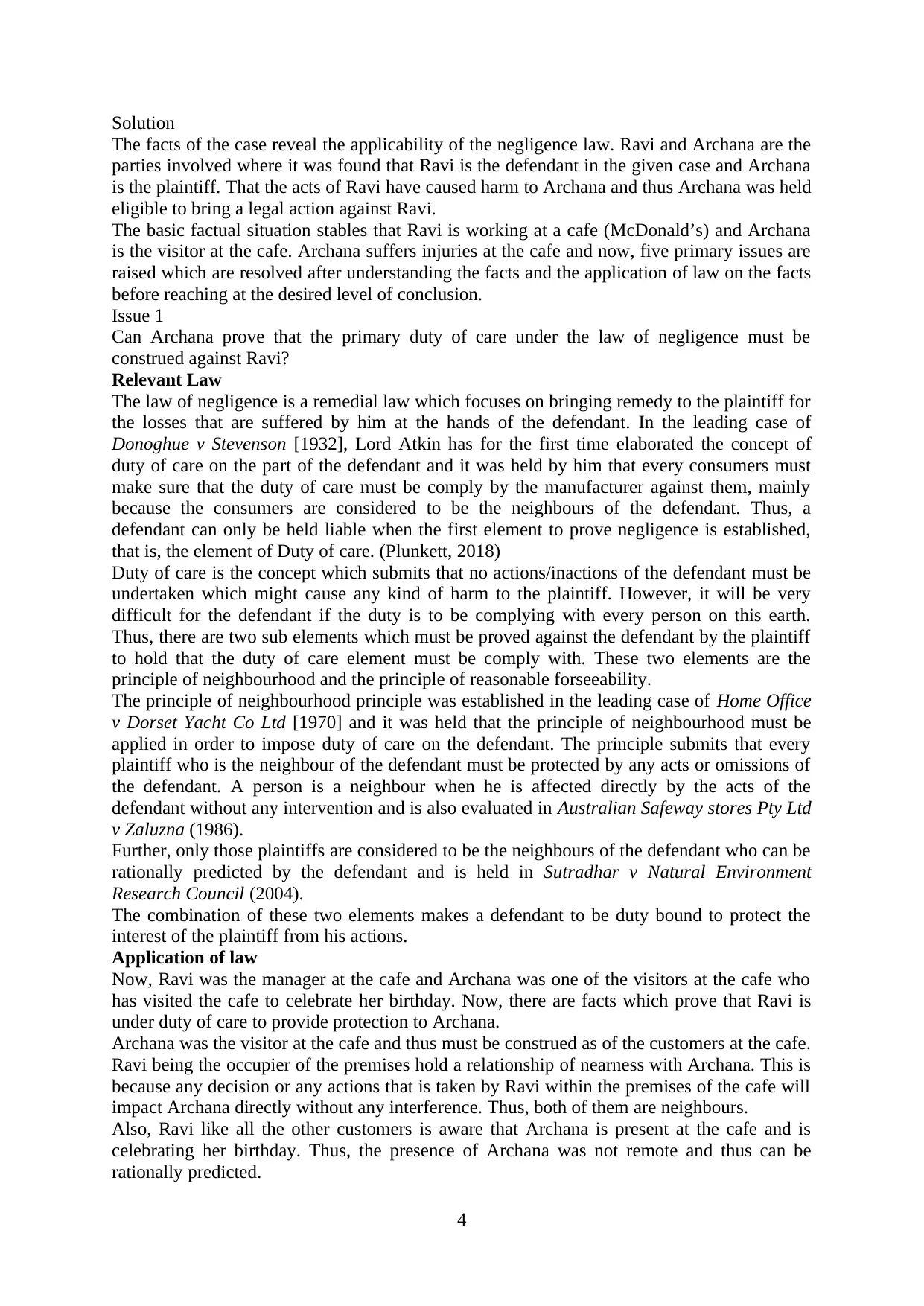
Solution
The facts of the case reveal the applicability of the negligence law. Ravi and Archana are the
parties involved where it was found that Ravi is the defendant in the given case and Archana
is the plaintiff. That the acts of Ravi have caused harm to Archana and thus Archana was held
eligible to bring a legal action against Ravi.
The basic factual situation stables that Ravi is working at a cafe (McDonald’s) and Archana
is the visitor at the cafe. Archana suffers injuries at the cafe and now, five primary issues are
raised which are resolved after understanding the facts and the application of law on the facts
before reaching at the desired level of conclusion.
Issue 1
Can Archana prove that the primary duty of care under the law of negligence must be
construed against Ravi?
Relevant Law
The law of negligence is a remedial law which focuses on bringing remedy to the plaintiff for
the losses that are suffered by him at the hands of the defendant. In the leading case of
Donoghue v Stevenson [1932], Lord Atkin has for the first time elaborated the concept of
duty of care on the part of the defendant and it was held by him that every consumers must
make sure that the duty of care must be comply by the manufacturer against them, mainly
because the consumers are considered to be the neighbours of the defendant. Thus, a
defendant can only be held liable when the first element to prove negligence is established,
that is, the element of Duty of care. (Plunkett, 2018)
Duty of care is the concept which submits that no actions/inactions of the defendant must be
undertaken which might cause any kind of harm to the plaintiff. However, it will be very
difficult for the defendant if the duty is to be complying with every person on this earth.
Thus, there are two sub elements which must be proved against the defendant by the plaintiff
to hold that the duty of care element must be comply with. These two elements are the
principle of neighbourhood and the principle of reasonable forseeability.
The principle of neighbourhood principle was established in the leading case of Home Office
v Dorset Yacht Co Ltd [1970] and it was held that the principle of neighbourhood must be
applied in order to impose duty of care on the defendant. The principle submits that every
plaintiff who is the neighbour of the defendant must be protected by any acts or omissions of
the defendant. A person is a neighbour when he is affected directly by the acts of the
defendant without any intervention and is also evaluated in Australian Safeway stores Pty Ltd
v Zaluzna (1986).
Further, only those plaintiffs are considered to be the neighbours of the defendant who can be
rationally predicted by the defendant and is held in Sutradhar v Natural Environment
Research Council (2004).
The combination of these two elements makes a defendant to be duty bound to protect the
interest of the plaintiff from his actions.
Application of law
Now, Ravi was the manager at the cafe and Archana was one of the visitors at the cafe who
has visited the cafe to celebrate her birthday. Now, there are facts which prove that Ravi is
under duty of care to provide protection to Archana.
Archana was the visitor at the cafe and thus must be construed as of the customers at the cafe.
Ravi being the occupier of the premises hold a relationship of nearness with Archana. This is
because any decision or any actions that is taken by Ravi within the premises of the cafe will
impact Archana directly without any interference. Thus, both of them are neighbours.
Also, Ravi like all the other customers is aware that Archana is present at the cafe and is
celebrating her birthday. Thus, the presence of Archana was not remote and thus can be
rationally predicted.
4
The facts of the case reveal the applicability of the negligence law. Ravi and Archana are the
parties involved where it was found that Ravi is the defendant in the given case and Archana
is the plaintiff. That the acts of Ravi have caused harm to Archana and thus Archana was held
eligible to bring a legal action against Ravi.
The basic factual situation stables that Ravi is working at a cafe (McDonald’s) and Archana
is the visitor at the cafe. Archana suffers injuries at the cafe and now, five primary issues are
raised which are resolved after understanding the facts and the application of law on the facts
before reaching at the desired level of conclusion.
Issue 1
Can Archana prove that the primary duty of care under the law of negligence must be
construed against Ravi?
Relevant Law
The law of negligence is a remedial law which focuses on bringing remedy to the plaintiff for
the losses that are suffered by him at the hands of the defendant. In the leading case of
Donoghue v Stevenson [1932], Lord Atkin has for the first time elaborated the concept of
duty of care on the part of the defendant and it was held by him that every consumers must
make sure that the duty of care must be comply by the manufacturer against them, mainly
because the consumers are considered to be the neighbours of the defendant. Thus, a
defendant can only be held liable when the first element to prove negligence is established,
that is, the element of Duty of care. (Plunkett, 2018)
Duty of care is the concept which submits that no actions/inactions of the defendant must be
undertaken which might cause any kind of harm to the plaintiff. However, it will be very
difficult for the defendant if the duty is to be complying with every person on this earth.
Thus, there are two sub elements which must be proved against the defendant by the plaintiff
to hold that the duty of care element must be comply with. These two elements are the
principle of neighbourhood and the principle of reasonable forseeability.
The principle of neighbourhood principle was established in the leading case of Home Office
v Dorset Yacht Co Ltd [1970] and it was held that the principle of neighbourhood must be
applied in order to impose duty of care on the defendant. The principle submits that every
plaintiff who is the neighbour of the defendant must be protected by any acts or omissions of
the defendant. A person is a neighbour when he is affected directly by the acts of the
defendant without any intervention and is also evaluated in Australian Safeway stores Pty Ltd
v Zaluzna (1986).
Further, only those plaintiffs are considered to be the neighbours of the defendant who can be
rationally predicted by the defendant and is held in Sutradhar v Natural Environment
Research Council (2004).
The combination of these two elements makes a defendant to be duty bound to protect the
interest of the plaintiff from his actions.
Application of law
Now, Ravi was the manager at the cafe and Archana was one of the visitors at the cafe who
has visited the cafe to celebrate her birthday. Now, there are facts which prove that Ravi is
under duty of care to provide protection to Archana.
Archana was the visitor at the cafe and thus must be construed as of the customers at the cafe.
Ravi being the occupier of the premises hold a relationship of nearness with Archana. This is
because any decision or any actions that is taken by Ravi within the premises of the cafe will
impact Archana directly without any interference. Thus, both of them are neighbours.
Also, Ravi like all the other customers is aware that Archana is present at the cafe and is
celebrating her birthday. Thus, the presence of Archana was not remote and thus can be
rationally predicted.
4
Paraphrase This Document
Need a fresh take? Get an instant paraphrase of this document with our AI Paraphraser
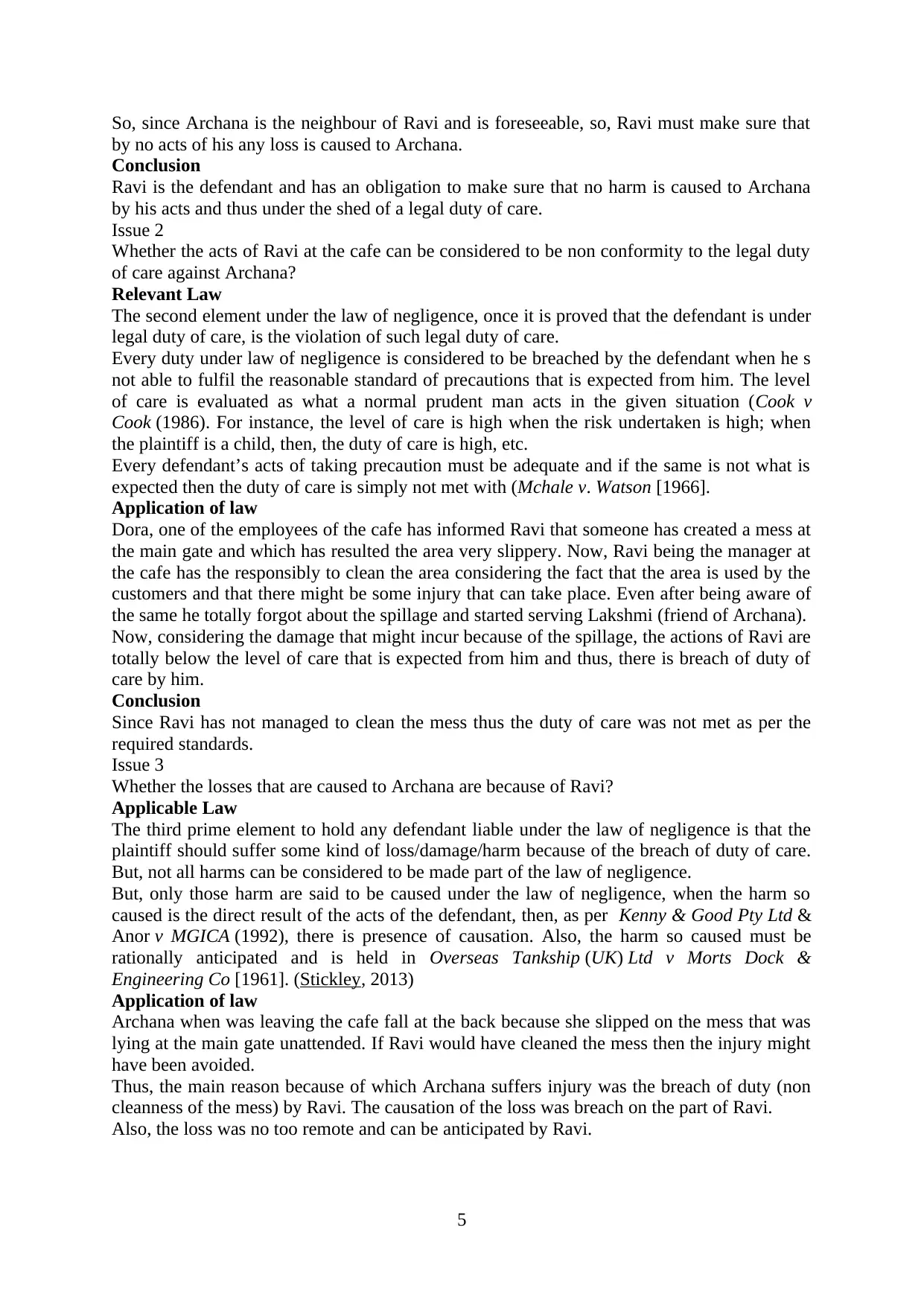
So, since Archana is the neighbour of Ravi and is foreseeable, so, Ravi must make sure that
by no acts of his any loss is caused to Archana.
Conclusion
Ravi is the defendant and has an obligation to make sure that no harm is caused to Archana
by his acts and thus under the shed of a legal duty of care.
Issue 2
Whether the acts of Ravi at the cafe can be considered to be non conformity to the legal duty
of care against Archana?
Relevant Law
The second element under the law of negligence, once it is proved that the defendant is under
legal duty of care, is the violation of such legal duty of care.
Every duty under law of negligence is considered to be breached by the defendant when he s
not able to fulfil the reasonable standard of precautions that is expected from him. The level
of care is evaluated as what a normal prudent man acts in the given situation (Cook v
Cook (1986). For instance, the level of care is high when the risk undertaken is high; when
the plaintiff is a child, then, the duty of care is high, etc.
Every defendant’s acts of taking precaution must be adequate and if the same is not what is
expected then the duty of care is simply not met with (Mchale v. Watson [1966].
Application of law
Dora, one of the employees of the cafe has informed Ravi that someone has created a mess at
the main gate and which has resulted the area very slippery. Now, Ravi being the manager at
the cafe has the responsibly to clean the area considering the fact that the area is used by the
customers and that there might be some injury that can take place. Even after being aware of
the same he totally forgot about the spillage and started serving Lakshmi (friend of Archana).
Now, considering the damage that might incur because of the spillage, the actions of Ravi are
totally below the level of care that is expected from him and thus, there is breach of duty of
care by him.
Conclusion
Since Ravi has not managed to clean the mess thus the duty of care was not met as per the
required standards.
Issue 3
Whether the losses that are caused to Archana are because of Ravi?
Applicable Law
The third prime element to hold any defendant liable under the law of negligence is that the
plaintiff should suffer some kind of loss/damage/harm because of the breach of duty of care.
But, not all harms can be considered to be made part of the law of negligence.
But, only those harm are said to be caused under the law of negligence, when the harm so
caused is the direct result of the acts of the defendant, then, as per Kenny & Good Pty Ltd &
Anor v MGICA (1992), there is presence of causation. Also, the harm so caused must be
rationally anticipated and is held in Overseas Tankship (UK) Ltd v Morts Dock &
Engineering Co [1961]. (Stickley, 2013)
Application of law
Archana when was leaving the cafe fall at the back because she slipped on the mess that was
lying at the main gate unattended. If Ravi would have cleaned the mess then the injury might
have been avoided.
Thus, the main reason because of which Archana suffers injury was the breach of duty (non
cleanness of the mess) by Ravi. The causation of the loss was breach on the part of Ravi.
Also, the loss was no too remote and can be anticipated by Ravi.
5
by no acts of his any loss is caused to Archana.
Conclusion
Ravi is the defendant and has an obligation to make sure that no harm is caused to Archana
by his acts and thus under the shed of a legal duty of care.
Issue 2
Whether the acts of Ravi at the cafe can be considered to be non conformity to the legal duty
of care against Archana?
Relevant Law
The second element under the law of negligence, once it is proved that the defendant is under
legal duty of care, is the violation of such legal duty of care.
Every duty under law of negligence is considered to be breached by the defendant when he s
not able to fulfil the reasonable standard of precautions that is expected from him. The level
of care is evaluated as what a normal prudent man acts in the given situation (Cook v
Cook (1986). For instance, the level of care is high when the risk undertaken is high; when
the plaintiff is a child, then, the duty of care is high, etc.
Every defendant’s acts of taking precaution must be adequate and if the same is not what is
expected then the duty of care is simply not met with (Mchale v. Watson [1966].
Application of law
Dora, one of the employees of the cafe has informed Ravi that someone has created a mess at
the main gate and which has resulted the area very slippery. Now, Ravi being the manager at
the cafe has the responsibly to clean the area considering the fact that the area is used by the
customers and that there might be some injury that can take place. Even after being aware of
the same he totally forgot about the spillage and started serving Lakshmi (friend of Archana).
Now, considering the damage that might incur because of the spillage, the actions of Ravi are
totally below the level of care that is expected from him and thus, there is breach of duty of
care by him.
Conclusion
Since Ravi has not managed to clean the mess thus the duty of care was not met as per the
required standards.
Issue 3
Whether the losses that are caused to Archana are because of Ravi?
Applicable Law
The third prime element to hold any defendant liable under the law of negligence is that the
plaintiff should suffer some kind of loss/damage/harm because of the breach of duty of care.
But, not all harms can be considered to be made part of the law of negligence.
But, only those harm are said to be caused under the law of negligence, when the harm so
caused is the direct result of the acts of the defendant, then, as per Kenny & Good Pty Ltd &
Anor v MGICA (1992), there is presence of causation. Also, the harm so caused must be
rationally anticipated and is held in Overseas Tankship (UK) Ltd v Morts Dock &
Engineering Co [1961]. (Stickley, 2013)
Application of law
Archana when was leaving the cafe fall at the back because she slipped on the mess that was
lying at the main gate unattended. If Ravi would have cleaned the mess then the injury might
have been avoided.
Thus, the main reason because of which Archana suffers injury was the breach of duty (non
cleanness of the mess) by Ravi. The causation of the loss was breach on the part of Ravi.
Also, the loss was no too remote and can be anticipated by Ravi.
5
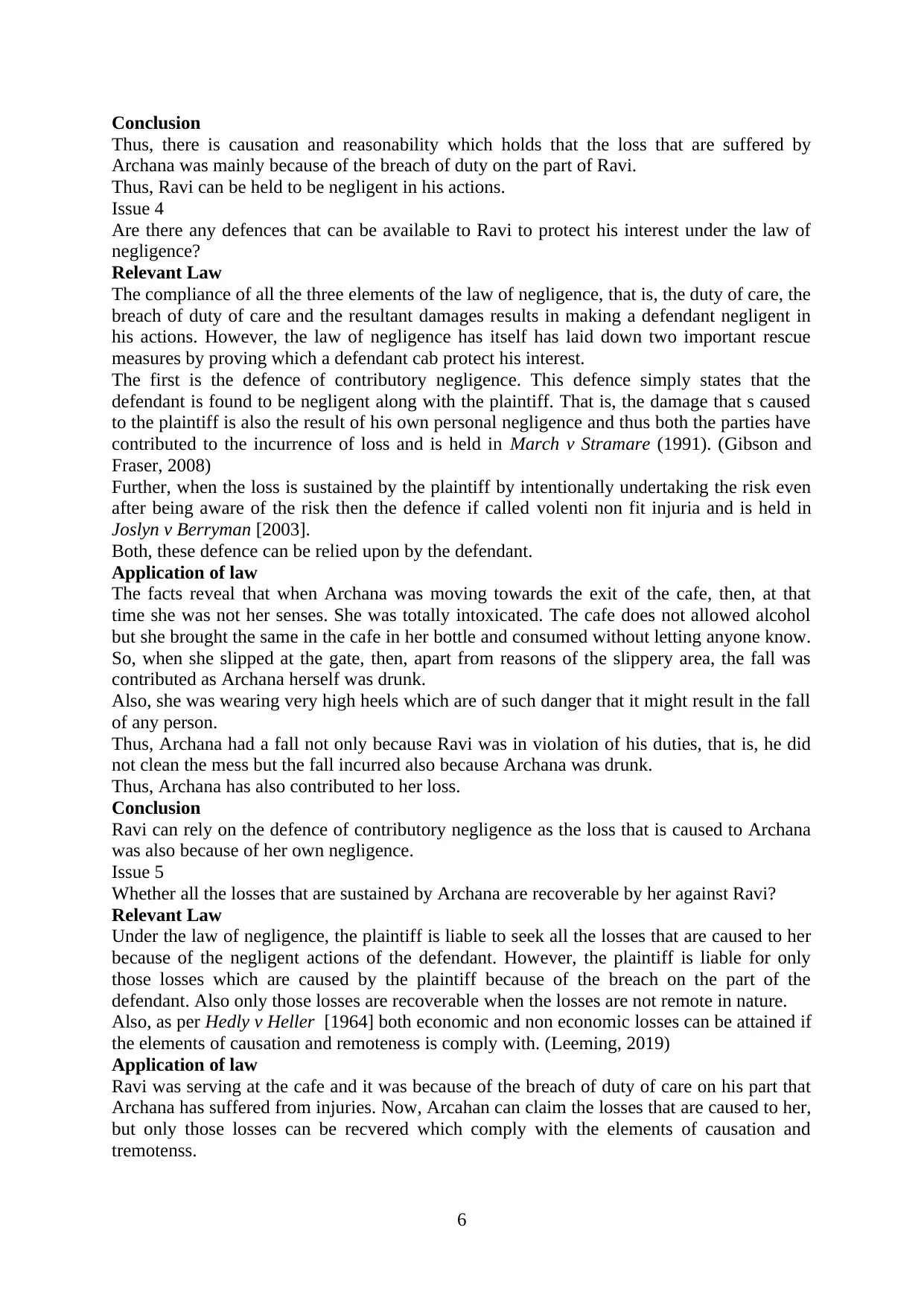
Conclusion
Thus, there is causation and reasonability which holds that the loss that are suffered by
Archana was mainly because of the breach of duty on the part of Ravi.
Thus, Ravi can be held to be negligent in his actions.
Issue 4
Are there any defences that can be available to Ravi to protect his interest under the law of
negligence?
Relevant Law
The compliance of all the three elements of the law of negligence, that is, the duty of care, the
breach of duty of care and the resultant damages results in making a defendant negligent in
his actions. However, the law of negligence has itself has laid down two important rescue
measures by proving which a defendant cab protect his interest.
The first is the defence of contributory negligence. This defence simply states that the
defendant is found to be negligent along with the plaintiff. That is, the damage that s caused
to the plaintiff is also the result of his own personal negligence and thus both the parties have
contributed to the incurrence of loss and is held in March v Stramare (1991). (Gibson and
Fraser, 2008)
Further, when the loss is sustained by the plaintiff by intentionally undertaking the risk even
after being aware of the risk then the defence if called volenti non fit injuria and is held in
Joslyn v Berryman [2003].
Both, these defence can be relied upon by the defendant.
Application of law
The facts reveal that when Archana was moving towards the exit of the cafe, then, at that
time she was not her senses. She was totally intoxicated. The cafe does not allowed alcohol
but she brought the same in the cafe in her bottle and consumed without letting anyone know.
So, when she slipped at the gate, then, apart from reasons of the slippery area, the fall was
contributed as Archana herself was drunk.
Also, she was wearing very high heels which are of such danger that it might result in the fall
of any person.
Thus, Archana had a fall not only because Ravi was in violation of his duties, that is, he did
not clean the mess but the fall incurred also because Archana was drunk.
Thus, Archana has also contributed to her loss.
Conclusion
Ravi can rely on the defence of contributory negligence as the loss that is caused to Archana
was also because of her own negligence.
Issue 5
Whether all the losses that are sustained by Archana are recoverable by her against Ravi?
Relevant Law
Under the law of negligence, the plaintiff is liable to seek all the losses that are caused to her
because of the negligent actions of the defendant. However, the plaintiff is liable for only
those losses which are caused by the plaintiff because of the breach on the part of the
defendant. Also only those losses are recoverable when the losses are not remote in nature.
Also, as per Hedly v Heller [1964] both economic and non economic losses can be attained if
the elements of causation and remoteness is comply with. (Leeming, 2019)
Application of law
Ravi was serving at the cafe and it was because of the breach of duty of care on his part that
Archana has suffered from injuries. Now, Arcahan can claim the losses that are caused to her,
but only those losses can be recvered which comply with the elements of causation and
tremotenss.
6
Thus, there is causation and reasonability which holds that the loss that are suffered by
Archana was mainly because of the breach of duty on the part of Ravi.
Thus, Ravi can be held to be negligent in his actions.
Issue 4
Are there any defences that can be available to Ravi to protect his interest under the law of
negligence?
Relevant Law
The compliance of all the three elements of the law of negligence, that is, the duty of care, the
breach of duty of care and the resultant damages results in making a defendant negligent in
his actions. However, the law of negligence has itself has laid down two important rescue
measures by proving which a defendant cab protect his interest.
The first is the defence of contributory negligence. This defence simply states that the
defendant is found to be negligent along with the plaintiff. That is, the damage that s caused
to the plaintiff is also the result of his own personal negligence and thus both the parties have
contributed to the incurrence of loss and is held in March v Stramare (1991). (Gibson and
Fraser, 2008)
Further, when the loss is sustained by the plaintiff by intentionally undertaking the risk even
after being aware of the risk then the defence if called volenti non fit injuria and is held in
Joslyn v Berryman [2003].
Both, these defence can be relied upon by the defendant.
Application of law
The facts reveal that when Archana was moving towards the exit of the cafe, then, at that
time she was not her senses. She was totally intoxicated. The cafe does not allowed alcohol
but she brought the same in the cafe in her bottle and consumed without letting anyone know.
So, when she slipped at the gate, then, apart from reasons of the slippery area, the fall was
contributed as Archana herself was drunk.
Also, she was wearing very high heels which are of such danger that it might result in the fall
of any person.
Thus, Archana had a fall not only because Ravi was in violation of his duties, that is, he did
not clean the mess but the fall incurred also because Archana was drunk.
Thus, Archana has also contributed to her loss.
Conclusion
Ravi can rely on the defence of contributory negligence as the loss that is caused to Archana
was also because of her own negligence.
Issue 5
Whether all the losses that are sustained by Archana are recoverable by her against Ravi?
Relevant Law
Under the law of negligence, the plaintiff is liable to seek all the losses that are caused to her
because of the negligent actions of the defendant. However, the plaintiff is liable for only
those losses which are caused by the plaintiff because of the breach on the part of the
defendant. Also only those losses are recoverable when the losses are not remote in nature.
Also, as per Hedly v Heller [1964] both economic and non economic losses can be attained if
the elements of causation and remoteness is comply with. (Leeming, 2019)
Application of law
Ravi was serving at the cafe and it was because of the breach of duty of care on his part that
Archana has suffered from injuries. Now, Arcahan can claim the losses that are caused to her,
but only those losses can be recvered which comply with the elements of causation and
tremotenss.
6
⊘ This is a preview!⊘
Do you want full access?
Subscribe today to unlock all pages.

Trusted by 1+ million students worldwide
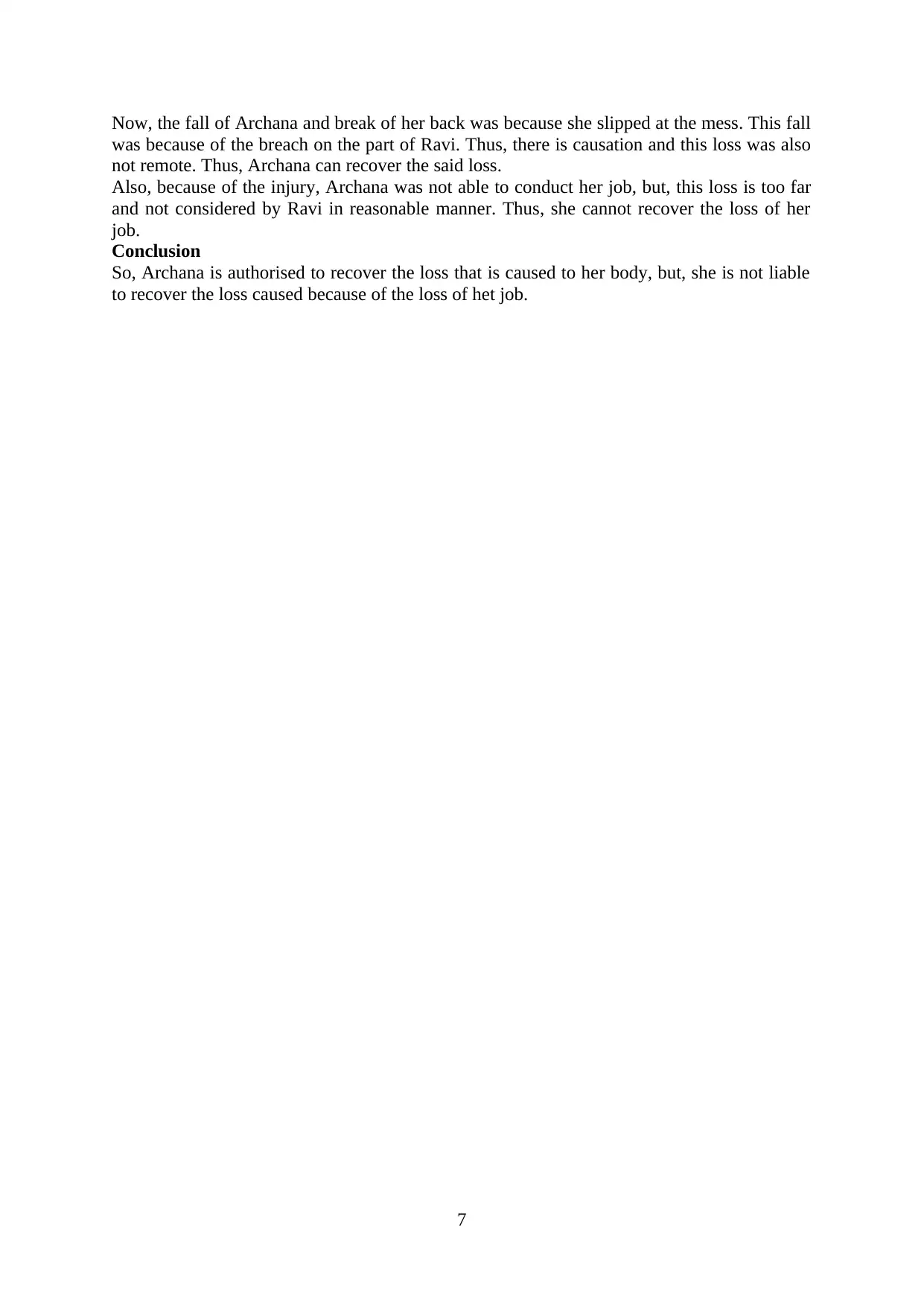
Now, the fall of Archana and break of her back was because she slipped at the mess. This fall
was because of the breach on the part of Ravi. Thus, there is causation and this loss was also
not remote. Thus, Archana can recover the said loss.
Also, because of the injury, Archana was not able to conduct her job, but, this loss is too far
and not considered by Ravi in reasonable manner. Thus, she cannot recover the loss of her
job.
Conclusion
So, Archana is authorised to recover the loss that is caused to her body, but, she is not liable
to recover the loss caused because of the loss of het job.
7
was because of the breach on the part of Ravi. Thus, there is causation and this loss was also
not remote. Thus, Archana can recover the said loss.
Also, because of the injury, Archana was not able to conduct her job, but, this loss is too far
and not considered by Ravi in reasonable manner. Thus, she cannot recover the loss of her
job.
Conclusion
So, Archana is authorised to recover the loss that is caused to her body, but, she is not liable
to recover the loss caused because of the loss of het job.
7
Paraphrase This Document
Need a fresh take? Get an instant paraphrase of this document with our AI Paraphraser
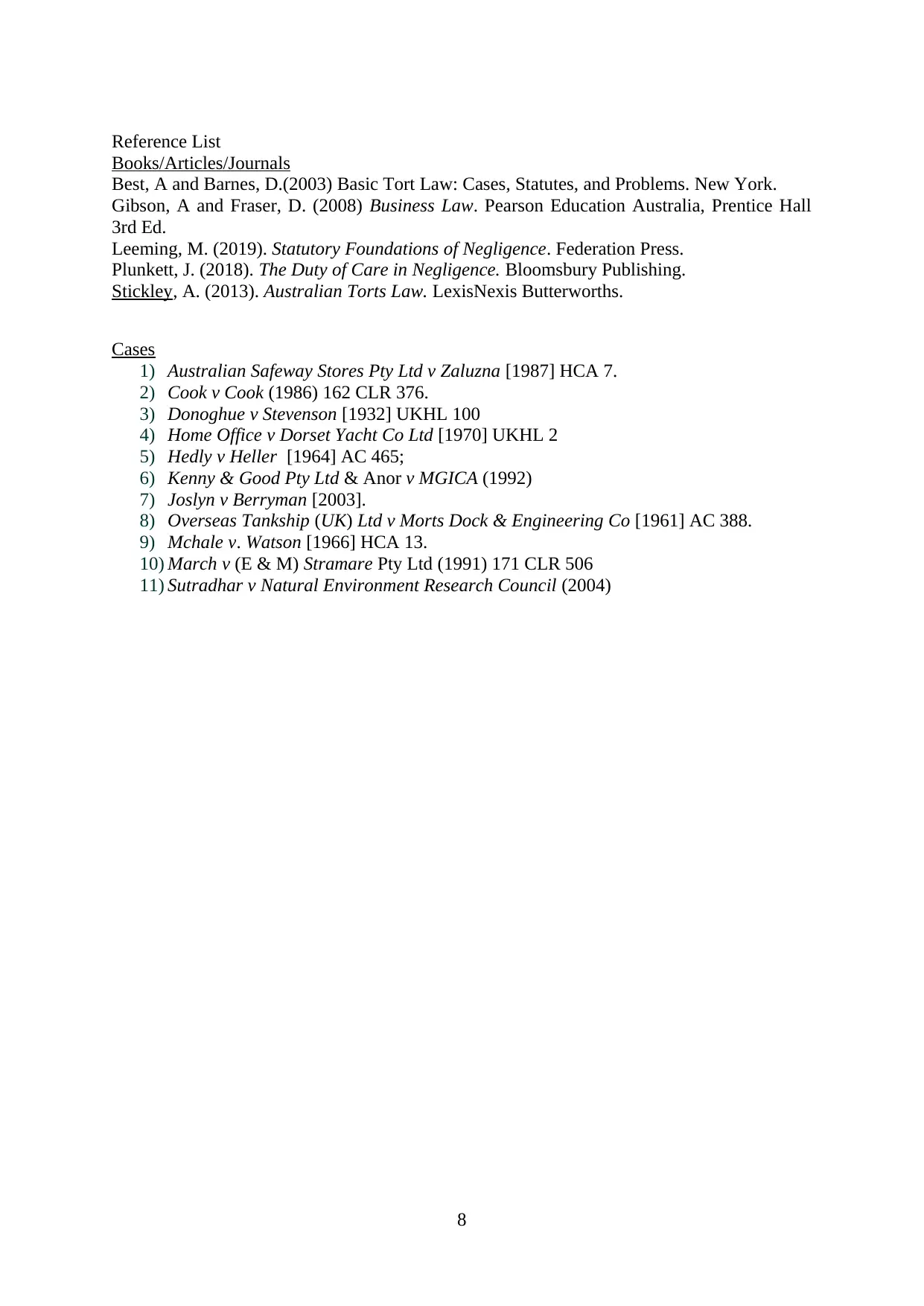
Reference List
Books/Articles/Journals
Best, A and Barnes, D.(2003) Basic Tort Law: Cases, Statutes, and Problems. New York.
Gibson, A and Fraser, D. (2008) Business Law. Pearson Education Australia, Prentice Hall
3rd Ed.
Leeming, M. (2019). Statutory Foundations of Negligence. Federation Press.
Plunkett, J. (2018). The Duty of Care in Negligence. Bloomsbury Publishing.
Stickley, A. (2013). Australian Torts Law. LexisNexis Butterworths.
Cases
1) Australian Safeway Stores Pty Ltd v Zaluzna [1987] HCA 7.
2) Cook v Cook (1986) 162 CLR 376.
3) Donoghue v Stevenson [1932] UKHL 100
4) Home Office v Dorset Yacht Co Ltd [1970] UKHL 2
5) Hedly v Heller [1964] AC 465;
6) Kenny & Good Pty Ltd & Anor v MGICA (1992)
7) Joslyn v Berryman [2003].
8) Overseas Tankship (UK) Ltd v Morts Dock & Engineering Co [1961] AC 388.
9) Mchale v. Watson [1966] HCA 13.
10) March v (E & M) Stramare Pty Ltd (1991) 171 CLR 506
11) Sutradhar v Natural Environment Research Council (2004)
8
Books/Articles/Journals
Best, A and Barnes, D.(2003) Basic Tort Law: Cases, Statutes, and Problems. New York.
Gibson, A and Fraser, D. (2008) Business Law. Pearson Education Australia, Prentice Hall
3rd Ed.
Leeming, M. (2019). Statutory Foundations of Negligence. Federation Press.
Plunkett, J. (2018). The Duty of Care in Negligence. Bloomsbury Publishing.
Stickley, A. (2013). Australian Torts Law. LexisNexis Butterworths.
Cases
1) Australian Safeway Stores Pty Ltd v Zaluzna [1987] HCA 7.
2) Cook v Cook (1986) 162 CLR 376.
3) Donoghue v Stevenson [1932] UKHL 100
4) Home Office v Dorset Yacht Co Ltd [1970] UKHL 2
5) Hedly v Heller [1964] AC 465;
6) Kenny & Good Pty Ltd & Anor v MGICA (1992)
7) Joslyn v Berryman [2003].
8) Overseas Tankship (UK) Ltd v Morts Dock & Engineering Co [1961] AC 388.
9) Mchale v. Watson [1966] HCA 13.
10) March v (E & M) Stramare Pty Ltd (1991) 171 CLR 506
11) Sutradhar v Natural Environment Research Council (2004)
8
1 out of 8
Related Documents
Your All-in-One AI-Powered Toolkit for Academic Success.
+13062052269
info@desklib.com
Available 24*7 on WhatsApp / Email
![[object Object]](/_next/static/media/star-bottom.7253800d.svg)
Unlock your academic potential
Copyright © 2020–2025 A2Z Services. All Rights Reserved. Developed and managed by ZUCOL.





